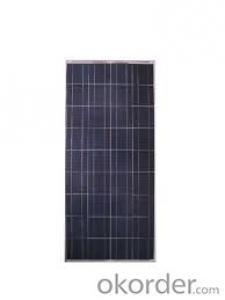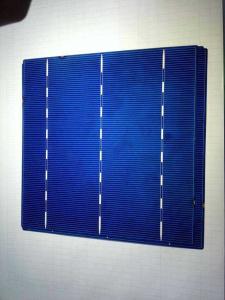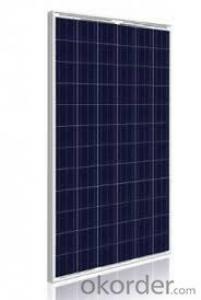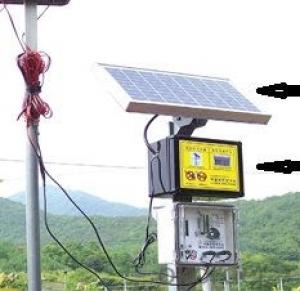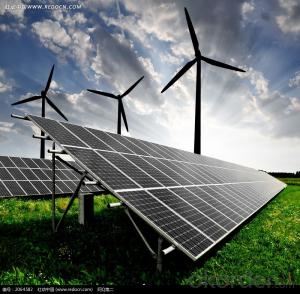Sunpower Solar Cells 235w Poly Solar Panel with 25 Years Warranty CNBM
- Loading Port:
- Qingdao
- Payment Terms:
- TT OR LC
- Min Order Qty:
- 10 set
- Supply Capability:
- 300000 set/month
OKorder Service Pledge
OKorder Financial Service
You Might Also Like
Polycrystalline Solar Modules
CNBM offers a range of small, medium and large polycrystalline solar modules, designed for a range of requirements.
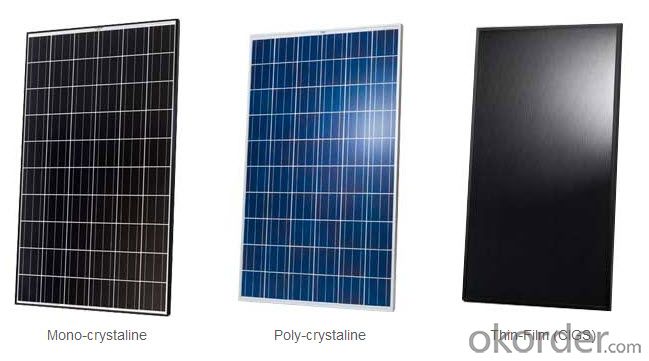
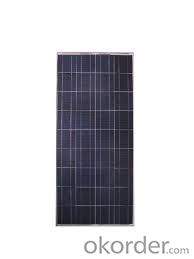
Specifications:
Tolerance | +/-3% |
Cell | Polycrystalline silicon solar cells (156 x 156mm) |
N0. of Cells | 60 (10 x 6) |
Dimension of Modules (mm) | 1650 x 990 x 40 |
Weight (kg) | 25.5 |
Limits:
Operating Temperature | -40~+85? |
Storage Temperature | -40~+85? |
Maximum System Voltage | 1000 VDC max. |
Hail Impact | Diameter of 28mm with impact speed |
Temperature and Coefficients:
NOCT | 48C+/-2? |
Voltage temperature coefficient (%/K) | -0.35 |
Current temperature coefficient (%/K) | 0.05 |
Power temperature coefficient (%/K) | -0.45 |
Characteristics:
Model: | SGM-200P | SGM-210P | SGM-220P |
Max-power voltage Vmp (V) | 29.2 | 29.4 | 29.41 |
Max-power current Imp (A) | 6.85 | 7.14 | 7.48 |
Open-circuit voltage Voc (V) | 36.5 | 36.69 | 36.9 |
Short-Circuit Current Isc (A) | 7.28 | 7.6 | 7.93 |
Max-power Pm(W) | 200 | 210 | 220 |
Model: | SGM-230P |
Max-power voltage Vmp (V) | 29.8 |
Max-power current Imp (A) | 7.72 |
Open-circuit voltage Voc (V) | 37.31 |
Short-Circuit Current Isc (A) | 8.19 |
Max-power Pm(W) | 230 |
STC: Irradiance 1000W/m2, module temperature 25?, AM-=1.5
Poly Crystalline Solar Panels Specifications Range
Maximum Power (Pm) | Dimension | Weight | Operating Voltage (Vmp) | Operating Current (Imp) | Open Circuit Voltage (Voc) | Short Circuit Current (Isc) |
0.45W | 140x80x10mm | 0.08kg | 3.3V | 150mA | 4.6V | 160mA |
1.0W | 162x140x10mm | 0.16kg | 7.5V | 150mA | 10.3V | 160mA |
4.5W | 269x251x23mm | 0.8kg | 16.5V | 0.27A | 20.5V | 0.3A |
10W | 420.1×268.9×22.6mm | 1.92kg | 17.5V | 0.58A | 20.5V | 0.6A |
20W | 425x502x50mm | 3.0kg | 16.8V | 1.19A | 21.0V | 1.29A |
30W | 593x502x22.6mm | 3.9kg | 16.8V | 1.78A | 21.0V | 1.94A |
40W | 655x537x50mm | 5.75kg | 17.3V | 2.31A | 22.1V | 2.54A |
50W | 839x537x50mm | 6.0kg | 17.5V | 2.9A | 21.8V | 3.17A |
65W | 1111x502x50mm | 7.2kg | 17.6V | 3.69A | 22.1V | 3.99A |
80W | 1204x537x50mm | 7.7kg | 17.6V | 4.55A | 22.1V | 4.8A |
- Q: How do solar cells impact greenhouse gas emissions?
- Solar cells have a positive impact on greenhouse gas emissions as they generate electricity from renewable and clean energy sources, such as sunlight. By utilizing solar cells to generate power, we reduce the reliance on fossil fuels, which are major contributors to greenhouse gas emissions. Therefore, solar cells help to mitigate climate change by reducing the overall carbon footprint and promoting a more sustainable and eco-friendly energy system.
- Q: Can solar cells be used in remote areas with no grid access?
- Yes, solar cells can be used in remote areas with no grid access. Solar cells, also known as photovoltaic (PV) cells, convert sunlight into electricity. They can be installed in off-grid locations where there is no access to a power grid, allowing the generation of electricity for various purposes. Solar cells are particularly beneficial in remote areas as they offer a sustainable and reliable source of clean energy, reducing the dependence on traditional fossil fuels and enhancing energy independence.
- Q: Can solar cells be used for electric vehicle charging?
- Yes, solar cells can be used for electric vehicle charging. Solar panels can generate electricity from sunlight, which can then be used to charge electric vehicle batteries. This allows for a sustainable and renewable source of energy for electric vehicle charging.
- Q: What is the solar cells market in China?
- Solar cells, is the "ideal" energy of human being's life, solar energy has changed the traditional way of obtaining energy by battery technology. But this technology is limited due to what solar cells needs to work- the weather factors, the solar energy battery can not work properly under rainy or cloudy weather. Therefore, solar cells market is not very well developed in some part of China where there are not much sun.
- Q: Can solar cells be used in remote areas?
- Yes, solar cells can be used in remote areas. Solar cells are a reliable and sustainable energy solution that can be installed in remote areas to generate electricity from sunlight, even in the absence of a traditional power grid. They provide an independent and cost-effective source of energy, making them ideal for powering remote communities, off-grid locations, and areas with limited access to electricity.
- Q: Can solar cells be installed on sloped surfaces?
- Yes, solar cells can be installed on sloped surfaces. In fact, sloped surfaces can often be advantageous for solar panel installation as they allow for better sun exposure and increased energy generation.
- Q: What happens to excess electricity generated by solar cells?
- Excess electricity generated by solar cells can be stored in batteries for later use, fed into the power grid to offset energy consumption, or utilized to power other devices or systems within the property.
- Q: What is the role of bypass diodes in solar cell systems?
- The role of bypass diodes in solar cell systems is to prevent the damage caused by shading or partial shading of the solar panels. These diodes provide an alternate path for the current to flow when some portions of the solar panels are shaded, ensuring that the rest of the panels can still generate electricity efficiently. By diverting the current around the shaded area, bypass diodes help to maintain the overall performance and reliability of the solar cell system.
- Q: Is the Photovoltaic Cells cheap to buy?
- If you are determined to get the solar cells to generate the power for you, Photovoltaic Cells are one of the cheapest things you can get.
- Q: How do solar cells handle shading or obstructions?
- Solar cells are designed to handle shading or obstructions by using bypass diodes. These diodes allow the current to bypass the shaded or obstructed area, ensuring that the remaining unshaded cells can still generate electricity. This helps minimize the impact of shading or obstructions on the overall performance of the solar panel.
Send your message to us
Sunpower Solar Cells 235w Poly Solar Panel with 25 Years Warranty CNBM
- Loading Port:
- Qingdao
- Payment Terms:
- TT OR LC
- Min Order Qty:
- 10 set
- Supply Capability:
- 300000 set/month
OKorder Service Pledge
OKorder Financial Service
Similar products
Hot products
Hot Searches
Related keywords
